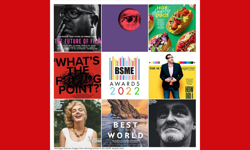
This Publishing Workflows Special consists of nine separate sections:
Content: the broad trends
Content commissioning & creation
Content publishing & distribution
Growth in multi-media / multi-channel
Carsten Althaber, director of marketing, vjoon, is seeing “more and more content being distributed via more and more channels”.
“For us,” says Adrian Barrick, group editorial director, Incisive Media, “the past year has accelerated the expansion of video and podcast content. These were strong pre-existing trends, but the mass digitisation of events has made these two formats integral to so much of what we do. Our video team has doubled in size over the past year.”
The effect of the pandemic on the events sector has also been felt at fellow B2B publishers, Ultima Media. Christopher Ludwig, editor-in-chief, writes: “Our content output has shifted significantly towards digital events, including making more use of the video assets for on-demand and related content. We have also increased online broadcast – namely in the form of more regular livestreams, webinars and podcasts.”
“Publishers are producing increasingly diverse media output with everything from multi-covered print editions through to short videos on TikTok,” says Sean Briggs, managing director, Creative Workflows.
This is as true in B2B as in B2C: “The days of black and white, text-heavy articles and reports are nearly over. Even the driest market information is now presented in colour with graphics and pictures which are often optimised for mobile access or widescreen presentations,” says Publish Interactive’s director of marketing & research, Edwin Bailey, who also notes the increase of what he describes as ‘blended media’ – “the increased use of different media to communicate the same information to the same audience. A written report may now be enhanced with video and visuals etc.”
One other consequence of the pandemic for Ultima Media has been the accelerated shift from print to digital: “With no more regular print,” says Ultima Media’ Christopher Ludwig, “we are not only focused more on online articles, newsletters and social media, but we have shifted to more digital, interactive publications (not just turning page PDFs).”
Content offerings are increasingly multi-layered affairs incorporating many different content types within a single piece. Jason Treloar, commercial director, Clock, sees publishers wanting to include “multiple content types for live events, or ongoing live news pieces, such as commentary of a sports event which includes audio, video, text content and commentary, interspersed with polling, social media, all seamlessly incorporated in an engaging stream.”
Steve Chapman, senior vice president, content partnerships, PressReader, is “seeing an increase in what we call compiled editions across the globe, which is where people are using web and feed-based content and auto-layout engines to create a daily edition or weekly edition of a newspaper or magazine.”
“We're seeing a bit of a smashing together of web-based content and e-paper based content. So, a lot of publishers, as part of their new strategies, are trying to bring those assets into the same apps, under the same subscriptions, to help create a better experience for end-users.”
Multiple usage
In much the same way that single use plastic is now frowned upon, publishers are becoming increasingly less tolerant of single-use editorial assets.
Phil Arnold, managing director, censhare (UK): “Most publishers are looking at how best to sweat the value of their assets, either within the publishing group across titles or countries as well as via licencing and syndication partnerships.”
“The drive towards diversification is accelerating as publishers look to partner with other companies to make use of product reviews as well as repurposing content to print and online channels as well as video, audio, mobile, social, products and web outputs.”
Catherine Westwood, group editor-in-chief, Future, says that they take a “360 degree approach to copy to ensure it is maximised to its full potential”.
Data as a product
At Ultima Media, they are “producing more business intelligence (deep dive reports, forecasts, data) for clients and in some cases on behalf of clients (for their own channels),” ways Christopher Ludwig.
Likewise at Incisive Media says Adrian Barrick: “We’re also expanding our use of data journalism and long-form formats as we strive to tell more valuable, actionable stories.”
Using data to tell a story is made possible, says Publish Interactive’s Edwin Bailey, because “technology has allowed data to be delivered in more visual formats, such as infographics or in interactive forms where the reader can ‘play’ or manipulate the data without having access to the raw numbers. Accompanying text is there for comment and opinion.”
Data as an editorial tool.
For Geoff Marsh, online director, Daily Express, a key trend is for content to be decided on the basis of analysis of reader data: “Data has changed everything. Ad-funded publishers are increasingly using data-driven insights to make decisions, both about their over-arching content strategies and the day-to-day running of newsrooms, right down to story selection and structure. It’s unthinkable now that we would make any major decisions without data-driven insight. Guesswork belongs in a museum. That’s not to say instinct is dead – just that good instinct increasingly relies on a foundation informed by solid insight, which comes from accurate data.”
Short or long?
Whilst the short-form vs long-form debate will continue to divide publishing opinion, two of our correspondents have detected increased demand for shorter form content.
In the B2B sphere, says Edwin Bailey, “long market reports published every 18-24 months are declining in popularity in favour of more frequent shorter reports or refreshed content.”
And in the newspaper world, Rich Mansell, solutions manager, PCS Publishing, says: “I’ve seen a shift in focus from longer form digital content to shorter, more focused articles. For a traditional news publisher, this means breaking the article into multiple digital articles at source, to then provide a single overview within the newspaper.”
Interested in finding out more about any of the suppliers quoted in this article? Check out the Supplier Spotlight section.
This article was first published in InPublishing magazine. If you would like to be added to the free mailing list, please register here.










